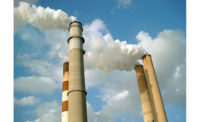With greenhouse gas emissions continuing to climb, the window to achieving international climate change goals is closing quickly, say the authors of a new United Nations climate report. The critical efforts needed to mitigate future impacts are still doable, though, the report notes—and the construction industry has a role to play.
The U.N. Intergovernmental Panel on Climate Change (IPCC) report, released April 4, includes some dramatic warnings. For example, it notes that GHG emissions will need to peak by 2025 at the latest, and be reduced by 43% by 2030, to reach the target of limiting global temperature rise to 1.5°C (2.7°F) from pre-industrial levels, a goal set by the 2015 Paris Agreement that scientists consider a threshold beyond which climate-related hazards will worsen.
“The reality is that greenhouse gas emissions, which are causing global warming, are at their highest levels in human history,” says Jim Skea, co-chair of the IPCC working group behind the report, which involve hundreds of researchers from about 80 countries. “Emissions in 2019 were about 12% higher than they were in 2010 and 54% higher than in 1990. So we are definitely not on track to limit warming to 1.5° Celsius.”
Buildings accounted for 21% of global greenhouse gas (GHG) emissions in 2019, including both direct embodied emissions from the production of construction materials and indirect emissions for offsite generation of electricity and heat, according to the .
The report is the third of a trio of working group reports that will inform the panel's climate change assessment that is due later this year.
Without strengthening mitigation efforts, the report’s authors project that global temperatures will instead rise by 3.2°C, Skea says. However, it appears that action to limit emissions and climate change is having an impact, he adds. The average annual global emissions growth rate slowed from 2.1% per year in the early 2000s to 1.3% per year between 2010 and 2019.
"Despite this progress, our assessment concludes that unless there are immediate and deep emissions reductions across all sectors, limiting warming to 1.5° will be beyond reach,” Skea says.
Building Changes
Diana Ürge-Vorsatz, vice chair of the working group, says buildings can reach net-zero emissions by 2050, but the current decade is a more critical target. It will be necessary to retrofit existing buildings and construct new ones with mitigation technologies.
Investment in decarbonizing buildings reached an estimated $164 billion in 2020. However, that “is not enough by far,” the report states.
Limited financing will be an obstacle to decarbonization. Governments will need to use building energy codes to reduce emissions from both existing and new buildings, IPCC authors say.
So-called “sufficiency” measures which, as opposed to short-term efficiency improvements, limit emissions by cutting demand for energy and materials over a building’s lifecycle, will be a key part of reducing building-related emissions, according to the report.
Those include use of nature-based solutions; designing buildings with shared space and allowing for their size to be adjusted to meet changing needs of households; repurposing unused buildings to reduce use of virgin materials; and using buildings’ thermal mass to reduce thermal needs. Globally, the report states those sufficiency measures could account for 17% of GHG mitigation potential in buildings by 2050.
The report projects that high-performance buildings will be the typical ones being built by 2050, though it’s critical to accelerate knowledge of related skills now to reduce the costs and remove constraints to achieve high-efficiency building at scale.
“More could be done to reduce emissions in the sector if renovation rates and retrofitting were improved,” Ürge-Vorsatz says.
More Mitigation
Other sectors where the report identifies mitigation potential could also impact future construction work, such as changes in the way cities are built and added transportation infrastructure to support electric vehicles.
Some of the greatest emissions reductions to date have been in the energy sector, where the report found adoption of renewable energy sources such as solar and offshore wind have increased dramatically since 2010, while their construction and operating costs have dropped—in some cases to levels below the cost of fossil fuels.
There are still paths for further mitigation in the sector, such as decentralizing energy networks so that power comes from multiple localized networks of renewables rather than one main electricity grid, Ürge-Vorsatz says.
Nathaniel Keohane, president of environmental policy and action nonprofit Center for Climate and Energy Solutions, said in a statement that the IPCC report is “sobering,” but he added that it also contains reasons to be hopeful about the future.
“Perhaps the best news is that the technologies we need to cut emissions sharply in the coming decade are widely available and getting cheaper by the day,” Keohane said. “Indeed, many means of cutting emissions, including generating electricity from wind and solar power, cutting methane emissions from oil and gas production and reducing energy demand across the economy, already pay for themselves.”






Post a comment to this article
Report Abusive Comment